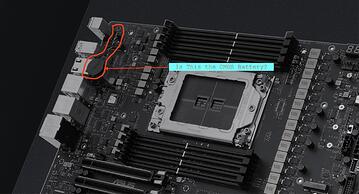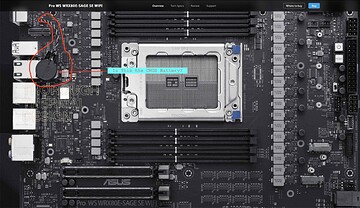TLDR - I ran lm_sensors command ‘sensors-detect’ on the ASUS Pro WS WRX80E-SAGE SE WIFI w/ 3975WX. I choose all the default options (i.e. hit enter to all the questions for what to run and what not to run). Immediately afterwards the following issues were prominent:
-
I no longer could get the video to work on the KVM
-
While I was in the OS (Fedora 35 Workstation Gnome) I kept seeing a message saying that ‘Activation of network connection failed’
I’m looking for help resolving these issues and getting my system back to working.
The Details:
My System Hardware:
- Asus Pro WS WRX80E-SAGE SE WIFI
- AMD 3975WX
- 256 GB ECC RAM (Crucial 3200 MHz)
- Sapphire Pulse 5500XT 8GB
- Corsair AX1600i PSU
- 2x 1TB Samsung 970 Evo
- 1 TB Samsung 980 Pro
- LSI SAS 9300-8i 8PT 12GB/S SATA+ SAS PCIE HBA (Avago 9300-8i storage controller)
- 3x Seagate 6TB IronWolf Pro connected to LSI HBA
- 3x WD 6TB Red connected to LSI HBA
- AMD 6900XT (Not connected to monitor at the time)
- 2x Samsung 850 EVO 500GB
Other System Details
- Running Fedora 35 Workstation - everything was up to date
- Running latest BIOS (0701) and Firmware (1.14.0)
Issues in More Detail:
KVM
When I try to power on the system with the KVM it will no longer provide video once the OS is fully booted. I do see the ASUS w/ Fedora Splash Screen while the OS is booting; but once it goes to the login screen the KVM just shows a black screen saying ‘No Signal’. Prior to running ‘sensors-detect’ I was able to get video output. Note that I still have keyboard and mouse control via the KVM. A couple of other things to note: 1) I do not see the screen to enter the BIOS (UEFI) via the KVM while booting (it does show on the monitor connected to the graphics card) nor am I able to enter the BIOS via the KVM by hitting the delete key; I’m not sure if I was able to access this prior to running ‘sensors-detect’ or not. 2) When starting and stopping the KVM I get some short audio static/popping feedback; this did not happen previous to the ‘sensors-detect’ command
Activation of network connection failed
I get this notice at the top of my desktop while using Fedora. It is intermittent. I have not experimented a ton, but it may only happen while I am also logged into the IPMI web service.
Things I’ve tried:
- Fresh install of Fedora 35 workstation
- Doing a firmware reset via the IPMI web service (note this did not seem to totally reset the firmware as it maintained the custom fan speed settings I had inputted previously, but it did reset the fan speed alarm levels)
- Doing a BIOS restore defaults via the BIOS interface
- Pressing the Clear CMOS button on the motherboard
I wanted to try removing the CMOS battery but I was not able to locate it. I scoured the internet and based on this picture, I think it maybe located under the rear I/O port shield/VRM heatsink. I’m not sure how to access this area. My fear is that I would need to uninstall the motherboard, remove the back plate of the motherboard, which would reveal some screws to take off the outer shield and access the battery. If so, this would take a lot of time. I’m fairly frustrated with ASUS’s design in this regard. If anyone can confirm where the CMOS battery is, and how best to access it, that would be helpful.
How You Can Help
Basically I am hoping someone can give me suggestion of things to try or check to get the functionality of my motherboard back. Or if they have had a similar experience are they able to confirm that it is repairable or did I permanently break my motherboard. For anyone interested, after encountering these problems I did more research and it seems I should probably use ipmitools to get sensor data. Also, as a PSA, it also looks like the last commit to the lm_sensors project was a year ago, so I’m not sure if it has been abandoned or not. While using the software it did provide some warnings, but I guess I was too trusting of the comments I read suggesting that if one used the defaults they were most likely safe.
Thanks in advance for any help you can provide! FYI - I live in Thailand so if you do offer help I may not respond right away do to the timezone difference.


